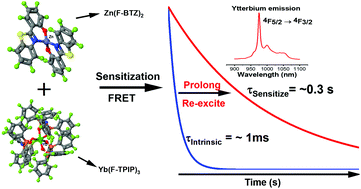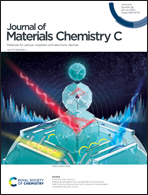Prolonged and efficient near-infrared photoluminescence of a sensitized organic ytterbium-containing molecular composite†
Abstract
Organic prolonged luminescent materials have attracted attention with various candidates reported providing both UV and visible emission for applications in bio-imaging, light storage, security, etc. However, there is a lack of prolonged near-infrared (NIR) emitting materials, which are highly desirable for many of the proposed applications. NIR-emitting organic lanthanide(III) molecules have suitable wavelengths, but all of them are unsuitable for persistent luminescence due to weak sensitization and the restricted intrinsic ion radiative lifetimes. Herein, this paper demonstrates efficiently sensitized organic Yb(III) compounds with prolonged emission lifetimes up to ∼0.3 s at 1 μm, far exceeding the intrinsic Yb3+ emission lifetime of ∼1 ms. The dynamic equilibrium is studied to demonstrate that this prolonged emission is caused by energy transfer from long-lived organic triplet excitons. Experiment and simulation results suggest a new route to develop bright and ultralong-lived 1 μm emitting materials that could be coupled with other existing organic persistent luminescence materials to shift their emission in to the infrared.



 Please wait while we load your content...
Please wait while we load your content...